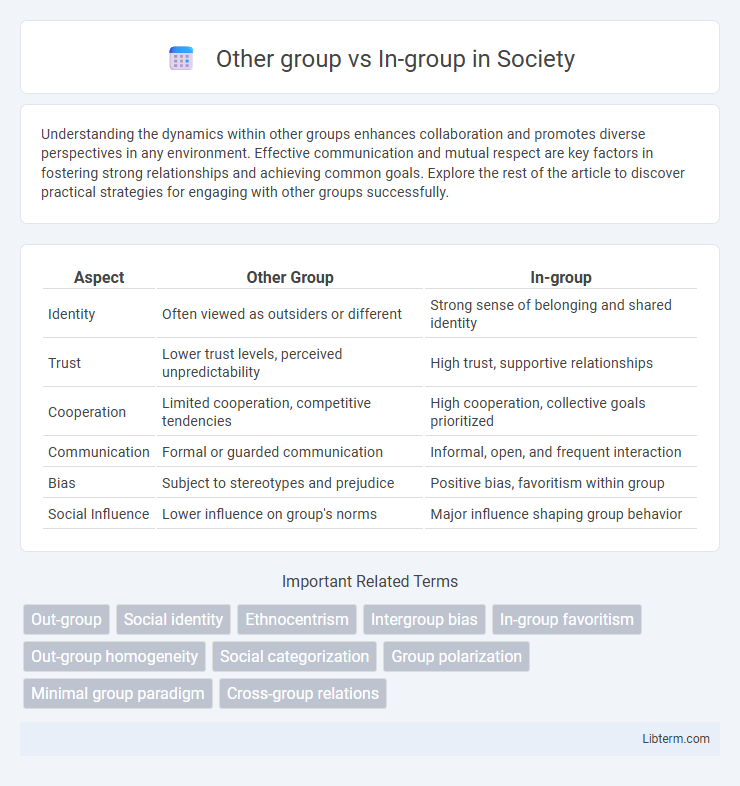Understanding the dynamics within other groups enhances collaboration and promotes diverse perspectives in any environment. Effective communication and mutual respect are key factors in fostering strong relationships and achieving common goals. Explore the rest of the article to discover practical strategies for engaging with other groups successfully.
Table of Comparison
| Aspect | Other Group | In-group |
|---|---|---|
| Identity | Often viewed as outsiders or different | Strong sense of belonging and shared identity |
| Trust | Lower trust levels, perceived unpredictability | High trust, supportive relationships |
| Cooperation | Limited cooperation, competitive tendencies | High cooperation, collective goals prioritized |
| Communication | Formal or guarded communication | Informal, open, and frequent interaction |
| Bias | Subject to stereotypes and prejudice | Positive bias, favoritism within group |
| Social Influence | Lower influence on group's norms | Major influence shaping group behavior |
Understanding In-Groups and Out-Groups
Understanding in-groups and out-groups is essential for analyzing social identity and group dynamics; in-groups are social groups to which an individual feels they belong, fostering a sense of loyalty and shared identity, while out-groups consist of those perceived as different or outside the group. Psychological theories like social identity theory highlight how favoritism towards in-groups and bias against out-groups shape behavior, influencing intergroup conflict and cooperation. Studying these distinctions aids in addressing prejudice, improving intergroup relations, and promoting social cohesion across diverse communities.
The Psychology Behind Group Dynamics
The psychology behind group dynamics reveals that in-group favoritism fosters strong social bonds and enhances cooperation within the group, while out-group categorization often leads to bias and stereotyping. Cognitive processes such as social identity theory explain how individuals derive self-esteem from group membership, promoting loyalty to the in-group and prejudice towards the other group. Understanding these dynamics is crucial for addressing intergroup conflict and improving social cohesion across diverse communities.
Social Identity Theory Explained
Social Identity Theory explains that individuals categorize themselves and others into in-groups and out-groups to enhance self-esteem and group cohesion. In-group members are perceived more positively and experience favoritism, while the "other group" or out-groups face stereotyping and discrimination. This psychological process reinforces social identities by emphasizing similarities within the in-group and differences with the out-group.
In-Group Favoritism: Causes and Effects
In-group favoritism arises from evolutionary psychology and social identity theory, where individuals prefer and prioritize members of their own group to enhance cohesion and survival chances. This bias strengthens group norms and loyalty but can lead to discrimination against out-group members, fostering stereotypes and social conflicts. Neuroimaging studies reveal heightened activity in reward-related brain regions when individuals favor their in-group, confirming the deep-rooted nature of this preference.
Out-Group Stereotypes and Prejudice
Out-group stereotypes often involve generalized and oversimplified beliefs about members of a group perceived as different, leading to biased attitudes and discriminatory behavior. Prejudice against out-groups is fueled by social categorization processes and can result in negative emotional responses and unfair treatment. Understanding the cognitive mechanisms behind out-group stereotypes is essential for addressing intergroup conflict and promoting social cohesion.
Impact of Group Membership on Behavior
Group membership significantly influences individual behavior by shaping norms, attitudes, and social identity within in-groups, leading to increased conformity and loyalty. The presence of an out-group, or "other group," often intensifies in-group cohesion while fostering biases or prejudice towards those outside the group. Social identity theory explains how people categorize themselves and others, impacting behaviors such as favoritism, discrimination, and collective action based on group affiliation.
The Role of Culture in Group Perception
Culture significantly influences group perception by shaping the criteria used to categorize individuals as either in-group members or others. Cultural norms dictate behaviors, values, and communication styles that reinforce in-group cohesion while often stereotyping or distancing out-groups. This dynamic affects social identity formation and intergroup relations, impacting collaboration, conflict, and social harmony across diverse cultural contexts.
Strategies to Overcome In-Group Bias
Strategies to overcome in-group bias include promoting intergroup contact through cooperative activities that encourage positive interaction between different groups. Implementing perspective-taking exercises helps individuals empathize with out-group members, reducing stereotypes and prejudices. Organizational policies aimed at diversity and inclusion foster an environment where equality is emphasized, minimizing favoritism towards the in-group.
Real-World Examples of Group Divisions
In-group and out-group distinctions are evident in political party affiliations where loyalty to one's party often fosters bias against opposing groups, impacting policy support and intergroup relations. Sports teams create strong in-group identities, with fans displaying favoritism toward their team and sometimes exhibiting hostility toward rival fans, influencing social behavior and community cohesion. Religious communities also highlight in-group vs. out-group dynamics, as shared beliefs reinforce group solidarity while outsiders may face exclusion or prejudice, affecting social inclusion and conflict.
Promoting Inclusion and Intergroup Harmony
Promoting inclusion and intergroup harmony involves recognizing and valuing both in-group and out-group members to reduce biases and foster mutual respect. Strategies such as intergroup dialogue, cooperative activities, and inclusive policies emphasize shared goals and common identities to bridge divides. Empirical studies show that positive intergroup contact decreases prejudice and enhances social cohesion across diverse communities.
Other group Infographic

 libterm.com
libterm.com